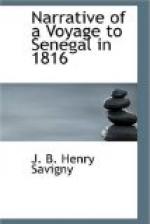Towards the middle of this town, if it may be so called, is a large manufactory in ruins, which is honored with the name of a fort, and of which the English have sacrificed a part, in order to make apartments for the governor, and to make the ground floor more airy, to quarter troops in it.
Opposite is a battery of heavy cannon, the parapet of which covers the square, on which are some trees, planted in strait lines for ornament. These trees are oleaginous Benjamins (Bens Oleferes) which give no shade, and ought to be replaced by tamarinds, or sycamores, which are common in this neighbourhood, and would thrive well on this spot. None but people uncertain of their privilege to trade on this river, merchants who came merely to make a short stay, and indolent speculators would have contented themselves with this bank of burning sand, and not have been tempted by the cool shades and more fertile lands, which are within a hundred toises, but which, indeed, labour alone could render productive. Every thing is wretched in this situation.
Saint Louis is but a halting place in the middle of the river, where merchants who were going up it to seek slaves and gum, moored their vessels, and deposited their provisions, and the goods they had brought with them to barter.
What is said in the narrative of the means of attacking this port, is correct. When the enemy have appeared, the Negroes have always been those who have defended it with the most effect. But unhappily, there, as in the Antilles, persons are already to be found, who are inclined to hold out their hands to the English.
At Louis there are some palm-trees, and the lantara flabelliformis. Some little gardens have been made; but a cabbage, or a salad, are still of some value. Want, the mother of industry, obliged some of the inhabitants, during the war, to turn their thoughts to cultivation, and it should be the object of the government to encourage them.
[A15] XXIV.—On the Islands of Goree and Cape Verd.
At the distance of 1200 toises from the Peninsula of Cape Verd, a large black rock rises abruptly, from the surface of the sea. It is cut perpendicularly on one side, inaccessible in two-thirds of its circumference, and terminates, towards the south, in a low beach which it commands, and which is edged with large stones, against which the sea dashes violently. This beach, which is the prolongation of the base of the rock, bends in an arch, and forms a recess, where people land as they can. At the extremity of this beach is a battery of two or three guns; on the beach of the landing-place, is an epaulement, with embrasures which commands it. The town stands on this sand bank, and a little fort, built on the ridge of the rock, commands and defends it. In its present state, Goree could not resist a ship of the line. Its road, which is only an anchoring place in the open sea, is safe in the most stormy weather; but it is exposed to all winds except those that blow from the island, which then serves to shelter it.




